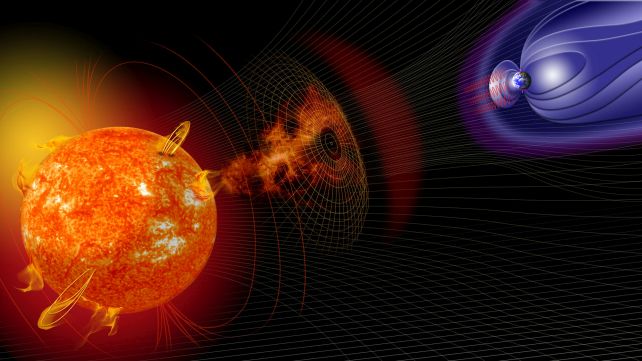Much bigger than the Carrington event.
The Carrington Event was a major reality check for a rapidly industrializing humanity. In September 1859, the Sun unleashed an eruption so powerful it sent electrical currents sweeping across Earth's surface, wiping out telegraph systems around the world, with fires and mayhem.
We've not seen its like since, but ancient evidence suggests that our Sun is capable of more –
so very much more. In the rings of ancient, partially fossilized trees, scientists have found evidence of a
solar storm at least an order of magnitude more powerful than the Carrington Event. It took place, they say, some 14,300 years ago, well before there was a technology grid to disrupt. Such events, more powerful than Carrington, appear periodically in the fossil record. But this one is the most powerful ever seen.
Solar, or geomagnetic, storms are common here on Earth. They occur when the Sun erupts in a colossal flare or coronal mass ejection. If the eruption occurs in the direction of Earth, a huge influx of charged particles will hit our magnetosphere.
A graphic showing a solar flare directed at Earth. (
NASA)
The effects of this are mostly pretty mild. The interaction between the particles and atmospheric molecules result in
some pretty spectacular auroras. It can disrupt satellite and
radio communications at certain bands. During particularly powerful (and thankfully relatively rare)
solar storms, the disruption to Earth's electromagnetic field can produce currents
that can impact power grids.
Another quirk of solar storms is the effect they have on the radioactive
carbon-14 constantly raining down on Earth. This radiocarbon is produced in the upper atmosphere as cosmic particles interact with atmospheric particles. Carbon-14 is incorporated into organisms, such as trees and animals, and because it decays at a known rate, scientists can use it to determine
when these organisms lived. And it can also reveal
historical solar eruptions, hidden in the annual rings of old trees.
"Radiocarbon is constantly being produced in the upper atmosphere through a chain of reactions initiated by cosmic rays,"
explains geologist Edouard Bard of the Collège de France and European Centre for Research and Teaching in Environmental Geosciences (CEREGE).
"Recently, scientists have found that extreme solar events including solar flares and coronal mass ejections can also create short-term bursts of energetic particles which are preserved as huge spikes in radiocarbon production occurring over the course of just a single year."
https://www.sciencealert.com/giant-...s-ago-leaves-the-carrington-event-in-the-dust


